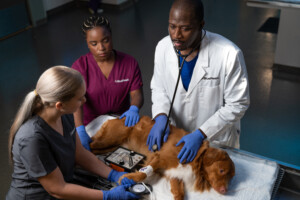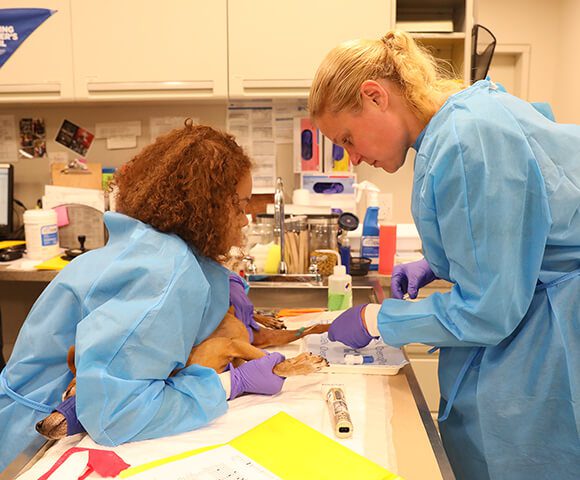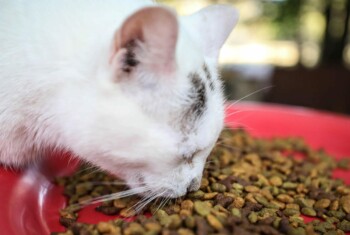What is GDV?
GDV is an emergency situation in which a dog’s stomach becomes twisted. As the stomach becomes distended, it usually twists in a clockwise direction. After the stomach is twisted and distended, the esophagus and duodenum become twisted and kinked off, thus trapping the gas in the stomach. The twist in the stomach not only makes the pet very uncomfortable but also impairs the blood flow to the stomach; thus, if left untreated, it may result in the death of the stomach and, ultimately, the death of the patient.
GDV and bloat are often used interchangeably, but the two terms are not exactly synonymous. GDV refers to the specific condition of the distention and subsequent twisting or flipping of a dog’s stomach. Stomach bloat is a more general term that describes the visible appearance of when a dog’s stomach becomes distended with gas. In some cases, the stomach is distended with fluid or food. Bloat can be used to describe a dog with GDV, but it is not a medical term used to identify this specific condition.
Another event that occurs with GDV is occlusion of the main vein (vena cava) leading from the back half of the body to the heart and resultant shock. Shock, a condition that causes inadequate perfusion of the body with blood, is fatal if not treated.
Clinical signs and symptoms

GDV prevents the outflow of fluid and food from the stomach. It can also cut off blood flow to the stomach and heart, which is what makes this condition so dangerous. Blood supply to the spleen can also be limited, causing damage to this organ too.
Dogs affected by GDV may appear restless or just generally “off.” Owners may also notice unproductive retching as if attempting to vomit with no result. Depending on the dog’s body type, sometimes distention, or “bloating,” in the abdomen is visible too.
Clinical signs of bloat include:
- Unproductive retching
- Abdominal distension
- Pale gums
- Rapid heart rate
- Weak pulse
Causes
While GDV can occur in virtually any dog breed, it is more common in deep-chested dogs.
About 50% of all Great Danes will bloat during their lifetime. About 1 in 5 Irish wolfhounds will bloat in their lifetime.
Other susceptible breeds include standard poodles, bloodhounds, Akitas, Irish setters, German shepherds, dachshunds and Labrador retrievers. Females and males are equally affected.
Getting a diagnosis
A veterinarian can confirm a diagnosis of GDV with abdominal x-rays.
Treatment
Initially, intravenous fluids are administered to help reverse shock. Next, the patient is anesthetized, and a tube is passed from the mouth to the stomach to relieve gas and fluid buildup. The stomach is then rinsed with water to remove ingested food.
Following these pre-op procedures, the patient will be taken to surgery, where the stomach is untwisted. Here, the stomach is tacked to the right side of the body wall (gastropexy) to prevent the stomach from twisting again. Sometimes, a portion of the stomach has died (necrosed) and needs to be removed. If too much of the stomach is dead, euthanasia may be recommended. If the spleen has developed blood clots, it will be removed.
After surgery, the patient is carefully monitored in the intensive care unit. Intravenous fluid therapy is continued after surgery. In some cases, artificial plasma (hetastarch), plasma and blood transfusions may be needed. Pain is controlled after surgery with a variety of medications. Blood pressure, EKG and other vital signs are closely monitored.
Some veterinarians may offer alternative solutions for GDV, such as deflating the stomach. However, these temporary solutions do not prevent the stomach from returning to a twisted or flipped position.
Prevention
Preventative surgery can minimize the risk of bloat in high-risk patients such as great Danes, German shepherds, bloodhounds, Irish setters, Irish wolfhounds, standard poodles and other susceptible breeds.

This surgery, called prophylactic gastropexy, is done laparoscopically via two small incisions and the aid of a telescopic camera. The stomach is sewn to the inside of the body wall during this procedure, which can be done as early as six months of age (often at the time of spaying or neutering). This procedure has minimal morbidity, less anesthesia and surgery time, a short hospital stay (done as an outpatient surgery) and is less expensive than treating bloat.
There are no proven methods of dietary or lifestyle prevention of GDV. However, a general tip for a dog’s overall abdominal health is to avoid exercise immediately after a meal.
Prognosis
The prognosis for GDV depends on when it is recognized and surgically treated. If caught and treated early, the prognosis can be quite good. However, the longer the wait time for surgery, the poorer the prognosis. Unfortunately, GDV can be deadly without timely treatment.
If treated early, about 90-95% of dogs having surgery to treat bloat will survive. If a portion of the stomach is found to be dead at the time of surgery, the survival rate decreases to 50%.

Patients who have bloated are predisposed to abnormal heartbeats that, if left untreated, uncommonly may result in death. Disseminated intravascular coagulation uncommonly occurs and results in dysfunction of multiple internal organs, bleeding disorder and commonly death.
A gastropexy (stomach tack) can also break down and result in recurrent bloat and twisting of the stomach, but this is unusual (less than a 5% chance). Chronic recurrent bloat occurs infrequently but usually is due to very poor function of the muscle of the stomach.
Medication may be administered to improve stomach motility, but this will be effective in only about 50% of patients.
If you suspect your dog may have GDV, seek immediate veterinary attention from your primary veterinarian, if possible, or your closest 24/7 emergency pet hospital. Find a BluePearl Pet Hospital nearest to you.


